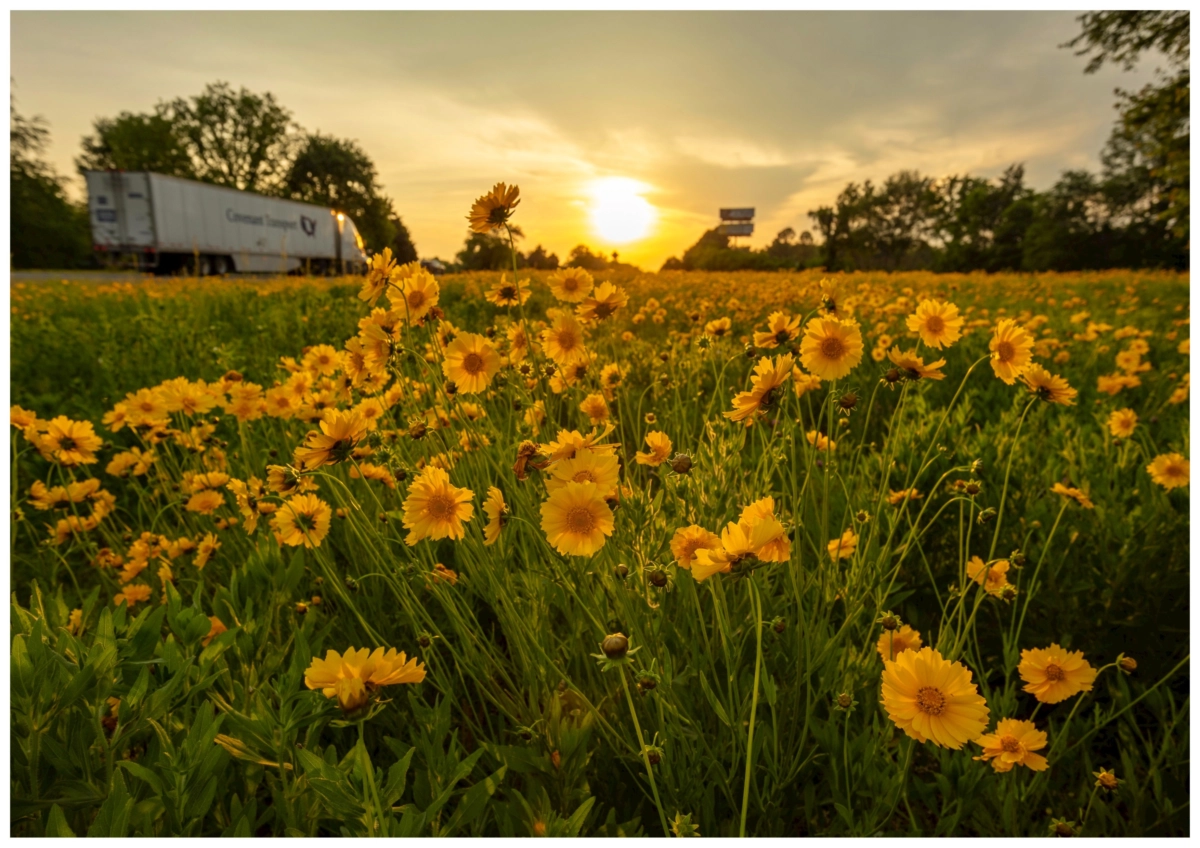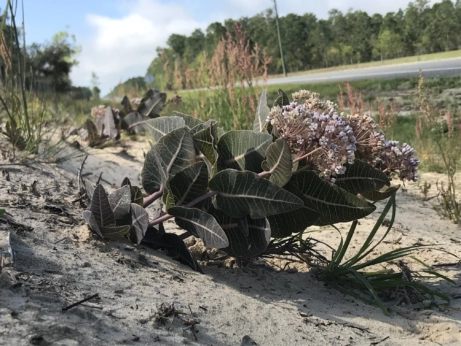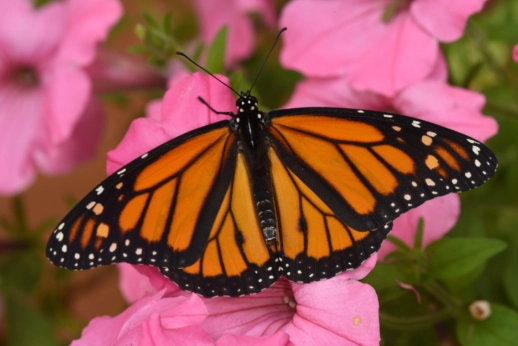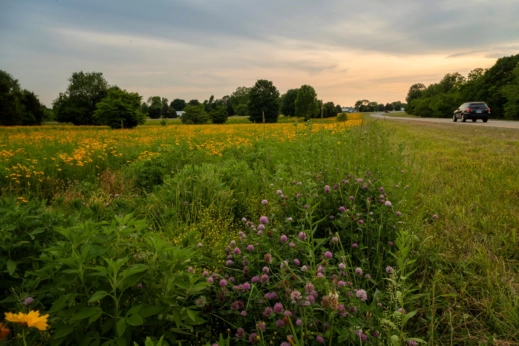State departments of transportation across the country are using their land to support pollinator conservation.

If you’re driving along the highway in Florida sometime soon, you may find the roadside dotted with the blooms of thousands of flowers. But they aren’t just eye candy. These flowers are intended to create pollinator habitat corridors.
According to Jaret Daniels, curator at the Florida Museum of Natural History, we no longer have the luxury of relying only on conservation lands to address biodiversity loss. Climate change, pollution, pesticides and habitat destruction are putting increasing pressure on pollinators, such as bees and butterflies. He says we need to look at nontraditional spaces as well, such as agricultural margins, utility corridors and roadsides. Although roads commonly fragment habitat for wildlife, pollinator programs, present in many states, flip the script and provide opportunities for conservation.
Daniels is the lead of a new $155,000 grant from the Florida Department of Transportation that will plant 9,000 milkweed plants along Florida highways over the next three years to support monarch breeding habitat. Monarchs depend on diverse ecosystems, but they only lay their eggs on milkweed.
Monarchs are a “gateway bug” to improving habitat, says Daniels. Planting the roadsides for monarchs will also be good for insect pollinators in general. Beyond that, pollinators such as bees are key participants in agriculture, and we depend on them for our food. These roadside plantings aim to connect habitat, rather than fragment it. State Departments of Transportation (DOTs), often managing some of the most land in the state, are uniquely positioned to address this task.
“Even these fairly urbanized areas still harbor a lot of diversity,” says Daniels. “And if you connect those spaces, then it enhances it even more to provide connectivity between populations and movement.”

A milkweed plant grows along an FDOT roadway. (Photo by Jaret Daniels)
From beautification to conservation
Planting flowers along roadsides isn’t a new idea. Lady Bird Johnson’s beautification efforts in the 1960s spread beyond cities and to the highways, and many states have been planting flowers on roadways for years.
But some of these beautification efforts have taken up a second purpose—pollinator conservation. North Carolina began its Wildflower Program in 1985, and it now manages 1,500 acres of wildflowers along major North Carolina thoroughfares.
About 15 years ago, says Derek Smith, roadside management engineering supervisor for the North Carolina Department of Transportation (NCDOT), discussion of pollinators entered the picture when a North Carolina State University scientist, Danesha Seth Carley, started studying the effects these plantings were having on pollinators. NCSU research confirmed that these roadside plantings drew in a higher number of bees and greater bee diversity.
The efforts then became intentional. The NCDOT planted gardens for monarchs at highway rest areas, welcome centers and wetland mitigation sites. Two of these welcome centers are certified monarch waystations on MonarchWatch.org.

An adult monarch. (Photo by Jaret Daniels)
Besides milkweed, NCDOT also plants a mix of perennial, annual and native plants. “Monarchs will nectar on all kinds of plants,” says Smith.
The decision to plant perennials and natives means that the NCDOT doesn’t need to go back every year to re-establish the plot. Additionally, it’s worked with the North Carolina Department of Agriculture to support farmers who want to grow flowers on their farm margins in support of pollinators.
“Transportation departments are one of the largest landowners in various states,” says Smith. “Why not take advantage of it if we can, and create habitat.”
More than milkweed
The milkweed movement is commonly associated with a way to help the monarch butterfly. In recent years, it’s become a popular way to support the species—since milkweed is the only type of plant on which monarchs will lay their eggs.
However, landscape designer and author Benjamin Vogt cautions against leaning too much on milkweed as the silver bullet for monarch conservation. Adult monarchs need a diversity of plants on which to nectar.
“A more diverse habitat planting fosters a thriving ecosystem, one in which countless other interactions are occurring, which not only benefit monarchs but all sorts of other butterfly and insect and bug species,” wrote Vogt to Modern Farmer in an email. “Gardening for monarchs means gardening for everyone else.”
[RELATED: Meet the Milkweed Man on a Quest to Help Monarch Butterflies]
Michael McClanahan of the Tennessee Department of Transportation is very familiar with the public’s love for milkweed. In 2023, the TDOT launched a program called Project Milkweed—free mail-order milkweed seeds for people to plant in their gardens to support monarchs. It ran out of seeds pretty quickly, restocked and ran out again. All in all, it received 130,903 individual orders, sending out a total of 799,601 packets of seeds.
“I think we were shocked,” says McClanahan. “It’s really shown us that people want to do the right thing. And that people are really passionate about trying to preserve their space and create these waystations for migrating pollinators.”

A meadow planted by TDOT at a highway interchange. (Photo by TDOT)
In Tennessee’s planting program, though, it goes beyond milkweed. It started a few years ago when NCDOT wanted to “up [its] game,” says McClanahan. It didn’t start with planting but with other pollinator-friendly practices on the roadsides. TDOT started mowing less. It began deploying fewer herbicides and changing up their herbicide mixes.
“That’s really kind of the genesis of our Pollinator Habitat Program is we started looking at our internal practices,” says McClanahan.
The program now boasts 11 sites, including welcome centers and state parks. Here, people can find diverse native plants, trees, bushes and grasses—such as partridge pea, false sunflower, frost aster and more.
For some of the roadside planting, McClanahan says sometimes people expect to see manicured, blooming gardens. But many of their plantings are focused on native diversity and won’t always be in full color. Habitat restoration goes beyond pretty blooms and improves the ecosystem as a whole.
“I think when you tell people that they’re native [plants], they’re more receptive to what’s out there.”
Use the space you have. Vogt doesn’t think you can necessarily “restore habitat” for pollinators in your backyard, but you can create a little island of resources. “Every plant matters,” says Vogt. “Every native plant matters more.” And if that island can connect to other islands, pollinators will be better off for it. “The more habitat we have in all shapes and form[s] the better,” says Vogt. He has published a few helpful books on this subject, including A New Garden Ethic: Cultivating Defiant Compassion for an Uncertain Future and Prairie Up.
Think local and make connections. “You can make simple steps in your own landscape to enhance and attract wildlife—plant native vegetation, reduce your lawn a little bit, diversify your landscape,” says Daniels. “And then as you’re going in and around your community, look at other spaces that have potential.” This could mean connecting with DOT officials, local government or even your homeowner’s association.
Use your resources if able. Smith says North Carolina’s Wildflower Program is not funded through tax dollars but through the purchase of personalized license plates. If you live in North Carolina, that’s a good way to support the continuance of the program. Other states have similar programs, such as Oregon, Colorado and Pennsylvania.
Go beyond planting. Pollinators experience pressures from pollution, chemical pesticides/herbicides and climate change. Addressing these issues in your community through advocacy or policy is an important way to support pollinators.
Learn more. There are many resources online for learning more about pollinator health and how to support them. Here are a few:
- Florida Wildflower Foundation.“They also have wildflower resolution templates on their website to work with local communities to try to increase planting along roadways or get areas designated as wildflower areas where mowing is reduced during spring bloom,” says Daniels.
- The Xerces Society. You can take part in nationwide movements for pollinators such as No Mow May.
- Tennessee DOT has a short series of educational videos online led by “Polli, the Bee from Tennessee.”
- Remember that there are some things that might seem helpful for pollinators but actually aren’t. Read about that here.

Great story! One other way to help pollinators right now: tell Congress to fund the Monarch and Pollinator Highway Program, which provides grants to state Departments of Transportation for these pollinator roadside projects. You can send a message to your representative here: https://environmentamerica.org/take-action/tell-congress-help-bees-and-butterflies-thrive/.
What happens when cars rush by, hitting Monarchs as they cross the road or flutter to close to the road?